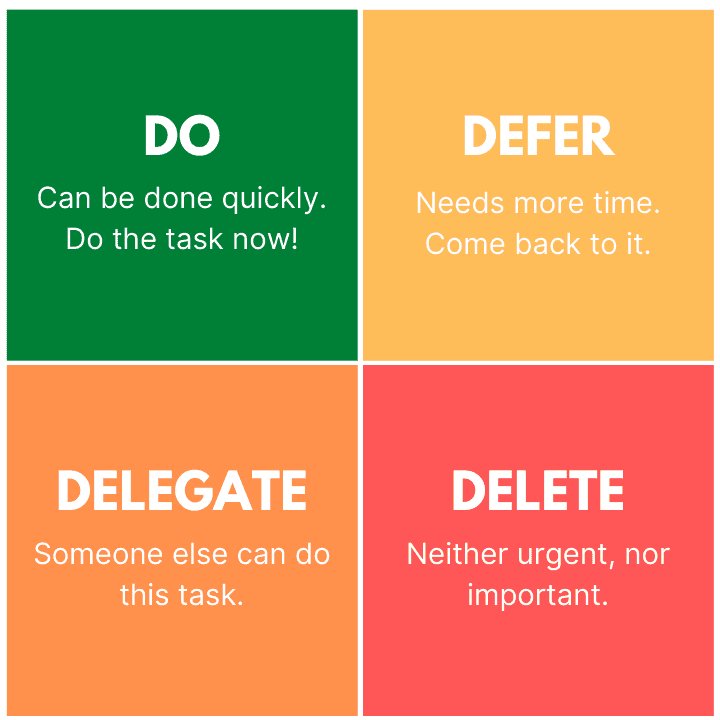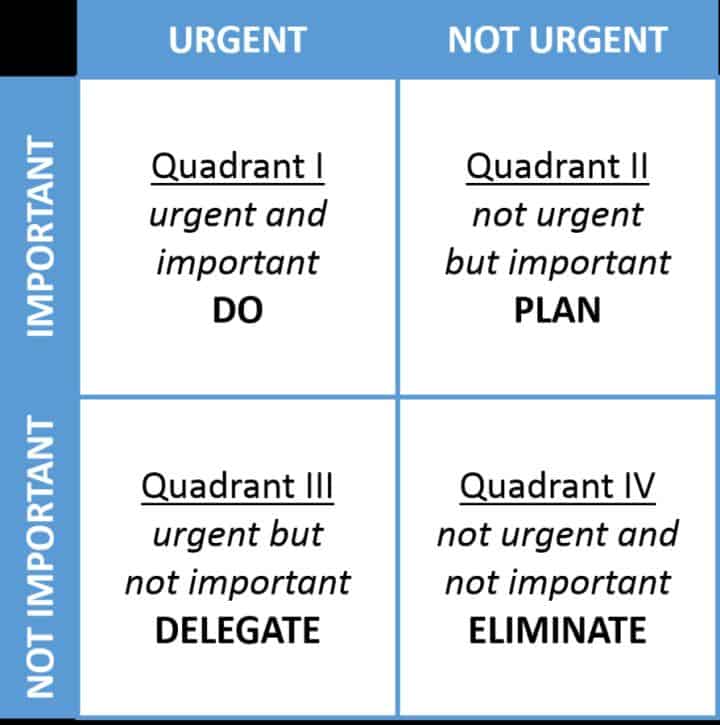There’s nothing more satisfying than checking off work on your to-do list. But before you attack your task list, you want to learn how to prioritize tasks.
Prioritizing tasks helps you:
- Meet deadlines by getting the most critical work done first.
- Better utilize scarce time and team resources.
- Effectively manage your team’s workload.
Project management tools help you capture, prioritize, and organize your work. You can also use simple task management tools — from simple to-do lists to visual Kanban boards — to get things done. But, irrespective of the tool, you need to learn how to prioritize work.
In this article, you’ll learn about prioritization methods. Here’s what we’ll cover:
- Make A Master Task List
- Categorize Tasks Using The 4Ds Of Time Management
- Prioritizing Tasks Using Eisenhower Power Matrix
- Prioritize Project Tasks Using The MoSCoW Method
- Prioritize Using Relative Priorities
- Focus On The Most Important Tasks Of The Day
- Do The Most Difficult Task First
- Prioritize Using The Pareto Principle
- Review & Revise Task Priorities
Ready to get started, let’s begin.
1. Make A Master Task List
Task requests come from various sources — your boss, different team members, colleagues, partners, and clients. Task requests can also come from multiple channels — emails, slack messages, or even a watercooler talk.
You need a way to capture all these requests and identify top priorities.
In addition, a task list also helps keep track of project progress. Plus, taking up the task request then, can mess up the rest of your schedule.
This is why you need a way to capture all your work in one place. It could be a notebook, a to-do list app on your phone, or the task backlog in your project management tool.
Once you have a list of all your tasks ready, you can easily categorize and prioritize them.
2. Categorize Tasks Using The 4Ds Of Time Management
Before you can prioritize your task items, you need to categorize each task in your master list into one of these four categories:
- Do the task now
- Defer the task to a later time
- Delegate the task to someone else
- Delete the task from your list

The “Do, Defer, Delegate, Delete” framework is also called the 4Ds of time management.
You can do a few tasks on your task list quickly. They take less than a minute or two. And there’s no dependency on anyone else. Go ahead and do these to trim down your to-do list.
A few other tasks can be done by your subordinates or team members. They have the skills and the necessary information to complete the work. Delegate this work to trim down your task list further.
You’ll also find some tasks that you don’t need to do anymore. They have been on your task list forever. Or, compared to the estimated effort involved, they provide very little value. Delete these from your list.
The only work that you’re left with now is the deferred tasks. You cannot do, delegate, or delete these. This is the work that needs prioritizing.
Next, let’s look at three ways to organize your tasks by priority.
3. Prioritizing Tasks Using Eisenhower Power Matrix
The Eisenhower four-quadrant, power matrix is a straightforward framework for prioritizing work.
Dwight Eisenhower — the 34th president of the United States — conceptualized the power matrix. But it was Steven Covey who made it popular in his best-seller — The 7 Habits Of Highly Effective People”.
The power matrix framework helps you answer two questions. Which tasks are important? And which tasks can be eliminated altogether?

To prioritize work using this framework, put each task into one of the four quadrants:
- Urgent and important
- Important, but not urgent
- Urgent, but not important
- Neither urgent nor important
Urgent and important tasks have the highest priority. Not doing these asap will have negative consequences.
Important but not urgent tasks will take up most of your time. Avoid neglecting these until the last minute to prevent unbalanced schedules and workloads.
Urgent but not important tasks can be delegated to your team. You don’t have to do them yourself.
Finally, you can eliminate tasks that are neither urgent nor important.
4. Prioritize Project Tasks Using The MoSCoW Method
Budget and time constraints are big challenges in project management. These challenges often directly affect the project’s outcomes.
The MoSCoW method helps prioritize work based on outcomes. Thus, it’s most effective when managing projects.
It was developed by Dai Clegg, a software engineer, during his tenure at Oracle.
This method helps stakeholders and clients understand the significance of each outcome in the final project delivery.
To use MoSCoW prioritization, divide your project outcomes into one of the four buckets:
- Must have: Outcomes without which the entire project is considered a failure
- Should have: Outcomes that are not as critical as must-have outcomes but still important
- Could have: Outcomes that can be delivered when you have budget or time remaining for final project delivery
- Won’t have: Outcomes that won’t be delivered with the project
Once you’ve categorized the outcomes above, you can prioritize work that supports these outcomes.
5. Order Tasks Using Relative Priorities
Using the prioritization strategies above often helps. But how do you order tasks with similar priority? What if you have lots of tasks that are important but not urgent? Or tasks that support must-have outcomes?
How do you prioritize items that have the same priorities? What prioritization methods do you use?
The answer is simple — using relative priority. Relative priority works by weighing the importance of each task compared to other tasks on the priority list. Then ordering the tasks based on this weight.
For example, let’s say you have ten work items. Assign a number from 1-10 to each task. And in no time, you’ll have sorted high and low priority tasks.
But, how do you decide which task is more important?
Two straightforward ways are to order work by their due dates and by dependencies. Tasks with an earlier deadline become priority tasks. Also, complete tasks that block other work from starting first.
Next, let’s look at three techniques that’ll help you breeze through your personal, prioritized task list.
6. Focus On The Most Important Tasks Of The Day
Leo Babuta of Zen Habits popularized the Most Important Tasks (MITs) method. This prioritization technique can help if you struggle to get daily tasks done even after prioritizing them.
To use the MITs method, choose up to three tasks that you want to get done today. These are your most important tasks. Complete these first.
Then if time permits, you can take up other miscellaneous work. This extra work is a bonus. You only work on bonus tasks if you finish the MITs.
You can consider your day successful even if you just do your MITs.
7. Do The Most Unwanted Task First
But what if you struggle to get through your MITs?
Thanks to Bryan Tracy’s method and his book — Eat That Frog! — you’ll have an answer in the following few paragraphs.
But what do frogs have in common with Task prioritization?
Mark Twain has the answer:
If it’s your job to eat a frog, it’s best to do it first thing in the morning. And if it’s your job to eat two frogs, it’s best to eat the biggest one first.
Once you’ve eaten the frog, there’s nothing worse you’ll have to tackle for the rest of the day. Replace frogs with tasks, and you’ll have your answer.
Most people put off complex tasks. And not because they’re less important. But only because they seem difficult. Bryan Tracy recommends you get unwanted work out of your way first. Then getting through the rest of the work becomes a breeze.
8. Prioritize Tasks Using The Pareto Principle
If you hate frogs like most people, the Pareto Principle is another popular way to blast through your daily task list. It’s also known as the 80/20 rule or the “law of the vital few.”
According to this principle, 80% of your day’s success depends on 20% of the tasks.
It’s tricky to identify the 20% work. The best way is to look at your MITs and pick one task you feel will make your day a success. For example, it could be an important task that provides the most value or takes up the most time.
Once you’ve identified the task, stay focused on getting that one task done.
Together the Pareto Principle and Bryan Tracy’s methods will help you blast through your daily task list.
9. Review & Revise Task Priorities
Do you know what the most frustrating thing about managing work is?
You’re halfway through your work plan, and suddenly tasks and/or priorities change. There’s little you can do with this change. It’s a risk that you have to live with.
Because of these changes, it’s critical to review and revise project task priorities often.
If budget, resource, or time constraints change, revise project priorities using the 4Ds framework, Eisenhower’s Power Matrix, or the MoSCoW method.
And if short-term priorities change, review and revise your relative task priorities.
Conclusion
Armed with the tips in this article, you’re now ready to tackle work and bring clarity to your team.
Speaking of clarity, you may want to check out Toggl Plan. It’s a beautifully simple work management tool that provides clear visual cues about what needs to be done, by whom, and when. For project managers, Toggl Plan comes with easy, drag-and-drop timelines that make planning work a breeze.
Start your free Toggl Plan team trial now.
Jitesh is an SEO and content specialist. He manages content projects at Toggl and loves sharing actionable tips to deliver projects profitably.
